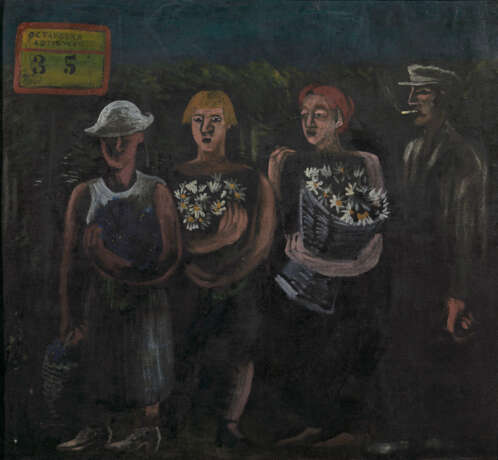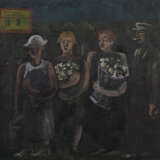RUBLEV, GEORGY (1902-1975) Village Klopovo , titled in Cyrillic, dated 1933 and with a portrait of a man on the reverse.
06.06.2018 12:30UTC +01:00
Classic
Продан
182000GBP £ 182 000
| Auctioneer | MacDougall Arts Ltd. |
|---|---|
| Место проведения | Великобритания, London |
Архив
Аукцион завершен. Ставки на лот больше не принимаются.

ID 70674
Лот 9 | RUBLEV, GEORGY (1902-1975) Village Klopovo , titled in Cyrillic, dated 1933 and with a portrait of a man on the reverse.
Оценочная стоимость
£ 120 000 – 180 000
Exhibited: Russian avant-garde, Panstwowa Galeria Sztuki, Sopot, 2012.
Literature: Exhibition catalogue, Russian avant-garde, Sopot, Panstwowa Galeria Sztuki, 2012, p. 90, illustrated.
The presence of Georgy Rublev’s work Village Klopovo, executed in 1933, in the current sale at MacDougall’s is a rare and extremely important event for the art market. Rublev is, arguably, one of the most remarkable and enigmatic painters of the Soviet era. He is likely to have painted this work while under the impression of the “oilcloths” of the great Niko Pirosmani. The dense black background, the unsettling range of colours and the sheer grotesqueness of the protagonists create a particular, unreal world, reminiscent of the notorious hidden, “behind-the-looking-glass” Soviet reality. In that other world, dream is intertwined with reality, while the clothing accessories of the characters, their faces and baskets of flowers are mysteriously ominous, as though foreshadowing a succession of some significant future events.
In 1922, while still very young, Rublev moved from his native Lipetsk to Moscow to continue his training with such famous painters as Sergei Gerasimov, Alexander Osmerkin and Ilya Mashkov. Having been stylistically influenced by the Jack of Diamonds, Rublev focussed on studying the approach to colour by the most progressive Western artists, especially Henri Matisse. This had a beneficial effect on his vivid artistic images, whose integrity had always been ensured by an impeccably thought-through system of bright splashes of colour reflecting the main conceptual framework of the picture.
However, in the troubled 1930s, when the artistic achievements of the Jack of Diamonds group were virtually stifled by the harsh official offensive against “formalism”, while the artists themselves had already long abandoned their Fauvist and Cubist quests, open formalist experimentation was out of the question. Rublev was forced to lead a double life, officially managing, as well as executing artistic commissions for Soviet pavilions and sports parades, while at the same time continuing to paint clandestinely, with the output confined to his table drawer.
It is possible that at that time only a few people got to see his extraordinarily bold compositions, which not only saved these works from annihilation but, in all likelihood, preserved the artist’s well-being and even his life. It is hard to believe that Rublev’s output in the 1930s was created during the horrendous period when for a single flippant image of Stalin (Stalin, 1934–1935, State Tretyakov Gallery) the artist could have ended up in a labour camp or even being executed. But it is precisely this “second” life of Rublev, and of his many outstanding, daring compatriots, that gives us today an idea of the true values and aspirations of the most progressive proponents of culture.
This masterpiece by Georgy Rublev would not look out of place in a private collection or even in the most prestigious museum exhibition.
| Адрес торгов |
MacDougall Arts Ltd. 63 New Cavendish St. W1G 7LP London Великобритания | |
|---|---|---|
| Предосмотр |
| |
| Телефон | +44 20 7389 8160 | |
| Телефон | +7 495 799 4683 | |
| Факс | +44 (0) 20 7389 8170 | |
| Условия использования | Условия использования | |
| Транспортировка |
Почтовая служба Курьерская служба Самовывоз | |
| Способы оплаты |
Банковский перевод |



